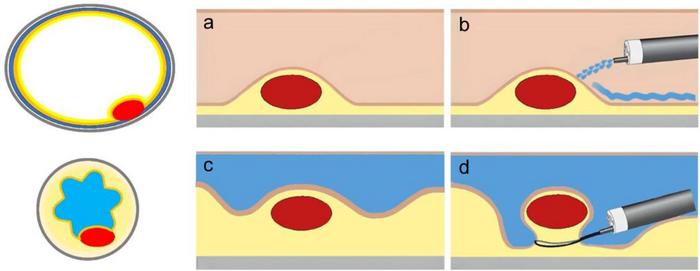Neuroendocrine tumors (NETs) of the gastrointestinal (GI) tract are a rare and heterogeneous group of malignancies arising from the neuroendocrine cell system. These tumors are more commonly encountered in the stomach, appendix, small bowel, rectum, and pancreas. Over the past few decades, the incidence of GI NETs has increased due to improved diagnostic capabilities and an aging population. The management of these tumors requires a careful assessment of various factors, including the site, size, grading, depth of invasion, and local lymphadenopathy, as they significantly impact prognosis and treatment options.

Credit: Gonçalves de Souza, Paula Arruda do Espirito Santo
Neuroendocrine tumors (NETs) of the gastrointestinal (GI) tract are a rare and heterogeneous group of malignancies arising from the neuroendocrine cell system. These tumors are more commonly encountered in the stomach, appendix, small bowel, rectum, and pancreas. Over the past few decades, the incidence of GI NETs has increased due to improved diagnostic capabilities and an aging population. The management of these tumors requires a careful assessment of various factors, including the site, size, grading, depth of invasion, and local lymphadenopathy, as they significantly impact prognosis and treatment options.
In recent years, endoscopic resection (ER) techniques have emerged as an increasingly important modality in the management of GI NETs. Among these, underwater endoscopic mucosal resection (UEMR) has garnered attention as a potential alternative to conventional mucosectomy techniques. The aim of this review is to comprehensively evaluate the feasibility and outcomes of UEMR in the treatment of GI NETs, thereby providing a reference for clinical decision-making.
Background and Objectives
UEMR was introduced as a novel technique to address the limitations of conventional endoscopic mucosal resection (EMR) and endoscopic submucosal dissection (ESD). EMR, though widely used, may fail to completely remove submucosal tumors, while ESD, though effective, requires advanced endoscopic skills and is prone to postoperative complications such as bleeding and perforation. UEMR, on the other hand, utilizes the buoyancy of water to lift the lesion, allowing for its resection without the need for submucosal injection.
The objective of this systematic review was to investigate the feasibility and outcomes of UEMR in the treatment of GI NETs, specifically focusing on esophageal, gastric, duodenal, ileal, and rectal NETs.
Methods
A systematic search was conducted across PubMed, Cochrane Library, and EMBASE databases to identify relevant studies published up to August 8, 2023. Studies reporting the use of UEMR in GI NETs were included, and data were extracted on study characteristics, patient demographics, tumor characteristics, and outcomes of interest such as en bloc resection, R0 resection, complete resection, and complications. The quality of the included studies was assessed using a modified version of the Joanna Briggs Institute (JBI) critical appraisal tool.
Results
The literature search identified a total of 64 records, of which 12 studies met the inclusion criteria and were included in the final analysis. These studies reported on 98 cases of UEMR performed for GI NETs, with most cases being rectal NETs (84 cases), followed by duodenal NETs (11 cases), gastric NETs (2 cases), and one case of ileal NET.
For esophageal NETs, the search did not identify any studies reporting UEMR outcomes. Given the rarity of esophageal NETs and the lack of standardized treatment guidelines, endoscopic removal, including UEMR, remains an unexplored area.
In gastric NETs, a pilot study involving two patients with G1 tumors reported complete resection without complications. However, the limited data suggest that further research is needed to establish the feasibility and efficacy of UEMR in this setting.
For duodenal NETs, 11 cases were reported, all of which achieved successful resection with UEMR. The technique demonstrated promising outcomes in this location, though larger studies are warranted to confirm its safety and effectiveness.
In the case of ileal NETs, only one outlier case was reported, highlighting the need for more extensive evaluation of UEMR in this site.
Finally, UEMR emerged as a favorable alternative to conventional ER techniques for rectal NETs, as evidenced by four comparative studies. The technique was shown to achieve complete histological resection at a lower cost, with a shorter procedure time and without the need for advanced endoscopic skills.
Conclusions
In conclusion, UEMR presents as a promising option for selected cases of GI NETs, particularly in the rectum. Its advantages of lower cost, shorter procedure time, and minimal requirement for advanced endoscopic skills make it an attractive alternative to conventional ER techniques. However, further research, including larger-scale studies and randomized controlled trials, is necessary to fully establish the safety, efficacy, and applicability of UEMR in different sites of GI NETs.
In light of the current evidence, clinicians should consider UEMR as a viable option in the management of selected GI NETs, especially rectal tumors, while remaining vigilant for emerging data that may inform future treatment guidelines.
Full text
The study was recently published in the Journal of Translational Gastroenterology.
Journal of Translational Gastroenterology (JTG) dedicates to improving clinical diagnosis and treatment, advancing understanding of the molecular mechanisms, and promoting translation from bench to bedside of gastrointestinal, hepatobiliary, and pancreatic diseases. The aim of JTG is to provide a forum for the exchange of ideas and concepts on basic, translational, and clinical aspects of gastroenterology, and promote cross-disciplinary research and collaboration.
Follow us on X: @xiahepublishing
Follow us on LinkedIn: Xia & He Publishing Inc.
Journal
Journal of Translational Gastroenterology
Article Title
Underwater Resection of Neuroendocrine Tumors of the Gastrointestinal Tract
Article Publication Date
25-Sep-2023



